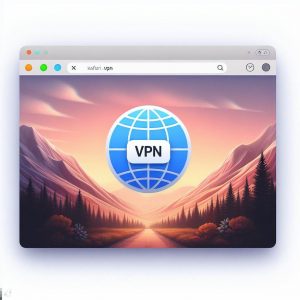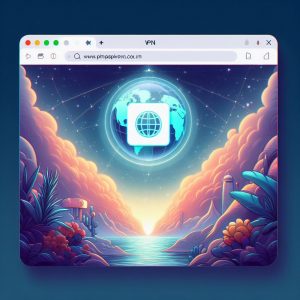Introduction
With online privacy and security becoming increasingly important in the digital age, using a virtual private network (VPN) has gone from an obscure precaution to a vital necessity for many internet users. A VPN can provide an encrypted tunnel for your internet traffic, preventing snooping or tampering by bad actors. It also allows you to mask your real location and IP address when browsing the web for added anonymity.
For Apple users, setting up a VPN specifically for the Safari web browser can greatly enhance privacy protections while using Safari. By routing Safari’s traffic through an encrypted VPN tunnel, sensitive web browsing activities become much more secure and anonymous. A Safari VPN configured properly acts as a shield against various cyberthreats that may otherwise compromise your online identity, data, and safety.
In this guide, we will explore what a VPN is, the VPN options available in Safari, how to set up and configure a Safari VPN, advanced VPN On Demand rules, and troubleshooting tips for common VPN problems. Read on to learn how to take control of your web browsing experience using a Safari VPN.
What is a VPN?
A virtual private network, or VPN, provides an encrypted tunnel for internet traffic between your device and a VPN server. This tunnel helps safeguard data from prying eyes on public Wi-Fi networks and allows users to bypass geography-based content blocks or censorship.
When connected to a VPN, your web traffic first routes to and from a VPN server before reaching its final internet destination. All data remains encrypted over the secure VPN tunnel, meaning your internet service provider (ISP) and hackers cannot monitor your browsing activity or see sensitive information like passwords, emails, or credit card numbers.
VPNs work by using tunneling protocols to encapsulate and encrypt your data packets as they travel inside the VPN tunnel between your device and a server. This prevents external parties from inspecting or modifying your traffic while in transit.
Some key benefits of using a reputable VPN include:
- Secure encrypted connections on public networks
- Masking your IP address and physical location
- Bypassing internet filters, firewalls, and censorship
- Protecting from data theft or tracking by ISPs
- Accessing region-restricted content globally
With a VPN in place, you can browse, bank, stream, and transmit data more safely and privately online.

Safari VPN Options
The macOS Safari web browser integrates directly with the native macOS VPN client to route traffic through a VPN tunnel automatically. The two main protocols supported for VPN connectivity are IKEv2/IPsec and WireGuard.
1. IKEv2/IPsec
Internet Key Exchange version 2 (IKEv2) is an IPsec-based tunneling protocol supported by iOS, macOS, and many third-party VPN services. It uses strong 256-bit AES encryption and supports perfect forward secrecy (PFS) for securing data. IKEv2 offers reliable speeds and a stable connection.
Nearly any VPN service that provides apps and configuration files for macOS/iOS should work seamlessly with Safari once installed and connected. This includes top providers like ExpressVPN, NordVPN, Private Internet Access (PIA), CyberGhost, PureVPN, and others.
4. WireGuard
WireGuard is a powerful new VPN protocol focused on high-performance connections, modern cryptography, and improved security. It is much simpler in architecture compared to older protocols like IKEv2 or OpenVPN.
WireGuard configures peer-to-peer encrypted tunnels between devices extremely quickly using state-of-the-art cryptography like Curve25519 for key exchange and ChaCha20 for encryption. Keys rotate much faster than older protocols, making traffic less vulnerable to brute force attacks. This improved encryption and faster handshakes lead to extremely secure yet responsive network connections.
Because WireGuard functions at the kernel level in iOS, iPadOS, and macOS, connections are very robust and efficient with little battery drain. Safari privacy and traffic routing benefit greatly thanks to these underlying performance and security advantages.
WireGuard works with Safari upon installing a VPN app with the proper certificate and configuration files provided by a VPN provider. Some top services fully supporting native WireGuard VPN for Apple products include Mullvad, IVPN, and AzireVPN.
Other VPN Options
Some VPN providers may offer additional protocols besides IKEv2 or WireGuard which can also integrate with Safari, like OpenVPN (UDP or TCP) and L2TP/IPSec. However, newer protocols tend to be faster and more secure overall.
No matter which protocol you choose, connecting to a VPN tunnels all Safari traffic through an encrypted pipe to shield browsing activity and data.
Setting Up a Safari VPN
Setting up Safari to use an encrypted VPN tunnel takes just a few steps. We will cover how to choose a quality VPN service, install VPN client software, configure connections, and start safeguarding Safari data traffic through the VPN.
Choosing a VPN Service
With countless VPN services to consider, research is crucial in selecting one you can trust. Key criteria to evaluate include:
- Privacy & Data Practices – Review if the VPN keeps minimal logs or is based in a country with strong consumer privacy laws. Avoid VPNs based in countries with intrusive data retention and surveillance regimes.
- Available Protocols – Having modern tunneling protocols like WireGuard or IKEv2 ensure fast and reliable connections across Safari and other apps.
- Device Support – Check for apps or configuration support across macOS, iOS, Android, and other devices to run the VPN everywhere needed.
- Pricing Structure – While free VPNs exist, paid services often provide better infrastructure, speeds, and commitment to protecting user privacy. Consider the price to value ratio when purchasing a subscription.
Based on these criteria, top choices to consider include ExpressVPN, Mullvad, Private Internet Access (PIA), IVPN, or CyberGhost among others.
Downloading and Installing the VPN Client
Once signed up with a chosen VPN provider, you can download the macOS VPN app from their website which will handle tunneling Safari traffic and encrypting your data. Top providers offer dedicated macOS apps which integrate natively with the OS VPN configuration system.
After downloading the VPN platform, install and launch the app. Sign in using the provided credentials and walk through the initial app setup steps as prompted. Leave the app open in the background to maintain the active VPN connection.
Configuring the VPN Settings
Within System Preferences > Network on a Mac, you should now see a new VPN connection configuration profile added under the VPN tab or menu labeled with your VPN service name and connection type like “Mullvad (WireGuard)”.
Click the gear icon to edit the VPN connection settings. Toggle “Connect on demand” to ON so the VPN triggers automatically when opening Safari or other supported apps. The “Sent traffic only” option routes only Safari browser traffic through the tunnel. Leave it unchecked to cover all device traffic.
Saving these settings will have Safari automatically route its browsing data through the encrypted VPN tunnel when launched!

VPN On Demand Rules
Building on the previous automated VPN connectivity, advanced users can configure granular VPN On Demand rules in macOS. These rules tell Safari and macOS when to trigger the VPN connection automatically based on specific criteria like Wi-Fi networks, domains accessed, or geo-locations.
2. Overview of VPN On Demand Rules
VPN On Demand is a built-in macOS feature for intelligently activating a VPN only when truly needed for privacy reasons or accessing blocked resources. This prevents keeping the VPN engaged needlessly during safe activities like basic email or office work on secured home Wi-Fi.
Rules are configured based on various connection attributes like Wi-Fi SSID, network interface type (Wi-Fi, Cellular, Ethernet), domain names, or even country/region codes when traveling internationally. For example, Safari can activate the VPN when joining an unsecured public Wi-Fi network but leave it dormant on known home/work Wi-Fi networks.
Activating VPN On Demand leads to better VPN reliability by only engaging when required instead of constantly. This minimizes connectivity overhead. Granular On Demand rules also prevent traffic leaks when shifting between networks or locations unexpectedly.
3. How to Set Up VPN On Demand Rules
Creating custom VPN On Demand rules entails:
- Navigate to System Preferences > Network in macOS
- Select the VPN connection under the VPN tab
- Click the gear icon and choose “Configure Rules”
- Click the + button to add new trigger rules
- Give rules a name and select the trigger type (Wi-Fi, Domain, SSID, etc)
- Input the rule criteria like publicly known Wi-Fi network names
- Test and tweak the rules as needed for desired VPN activation scenarios
Pro tip: Enable the “Evaluates connection immediately” option to test rules right away without reconnecting.
Common useful rules include activating the VPN for all NON home or work Wi-Fi networks, on cellular connections, when accessing financial or medical domains, or when physically out of country based on IP geolocation data.
Benefits of VPN On Demand
The main advantages of tailoring VPN On Demand activation rules are:
- Secure automated VPN usage only when truly required
- Eliminate privacy gaps based on context like networks
- Prevent traffic leaks as conditions change
- Optimize VPN reliability by minimizing constant tunnel overhead
- Customize VPN usage very specifically across networks, domains, countries
With Safari and macOS tightly integrated, fine-tuned VPN On Demand rules provide the next level of intelligent privacy protection matched to user needs and browsing contexts.
Troubleshooting Common Issues
While VPN setup is generally straightforward for surfing securely in Safari, there are a few common trouble areas users may encounter:
Connection problems
Basic VPN connectivity issues can stem from protocols being blocked on certain restrictive networks, misconfigured credentials/settings from user error, or even unstable VPN server infrastructure in some cases. Start troubleshooting with these checks:
- Disable Wi-Fi and retry over cellular data – If VPN connects wirelessly but not over home Wi-Fi, an external network issue may be blocking the VPN tunnel itself
- Retry connection with alternate protocols if available – For example, switch from IKEv2 to WireGuard
- Update VPN app and settings to latest version – Outdated software can prevent proper tunnel establishment
- Sign out then back into VPN app to redo credentials
- Contact VPN provider support to confirm all account, protocols, and apps are setup correctly
Catching basic user errors gets connections fixed quickly. But network restrictions or poor VPN infrastructure require provider engagement.
3. Bypassing LAN and Private Networks
In some scenarios, users may find their VPN prevents access to local private networks and shared file resources when activated. This occurs because the VPN redirects and encapsulates ALL network traffic through its encrypted tunnel, including local subnet and LAN traffic not actually requiring VPN protection.
Solutions include:
- Configuring VPN providers that offer a “Split Tunneling” option to exclude local private subnets from the VPN tunnel
- If split tunneling is unavailable, manually disconnecting the VPN when accessing local resources. Automated VPN On Demand rules can facilitate this context-based disconnecting behavior as well
Making the VPN avoid encapsulating traffic meant for local devices enables important network functionality to coexist alongside the VPN privacy tunnel.
Tips for Resolving Issues
Additional best practices for keeping VPN performance smooth include:
- iOS and macOS updates – Maintain devices updated to support latest network and VPN fixes
- Alternative connections – Toggle between Wi-Fi and Cellular data to compare VPN reliability over different mediums
- Location changes – Geo-based restrictions can temporarily disrupt VPN until switching regions
- VPN server switching – Connect through different provider endpoint locations to test stability
- DNS configuration – Use VPN provider DNS exclusively on device when troubleshooting instead of third-party or ISP servers
Staying updated and flexible across connectivity mediums, locations, and infrastructure often reveals the source of ongoing problems.

Conclusion
The privacy, security, and content access advantages of routing Safari web traffic through an encrypted VPN tunnel make the setup effort well worthwhile. As threats to user data and privacy escalate across industries and nations, leaning on a VPN’s protections while browsing offers peace of mind.
With macOS and Safari tightly integrated, configuring a native VPN connection only takes a few steps before containing all web activity inside an impenetrable encrypted tunnel. Expanding protection further, advanced VPN On Demand rules trigger the VPN automatically based on risky contexts like insecure public networks so users browse freely while reducing disruptions.
Setting up a Safari VPN stands as one of the most impactful steps Apple users can take to regain control over web browsing privacy in an age of unprecedented cyberattacks, surveillance overreach, and data exploitation. So get your preferred VPN service fired up on macOS and start securing your online world today through Safari.